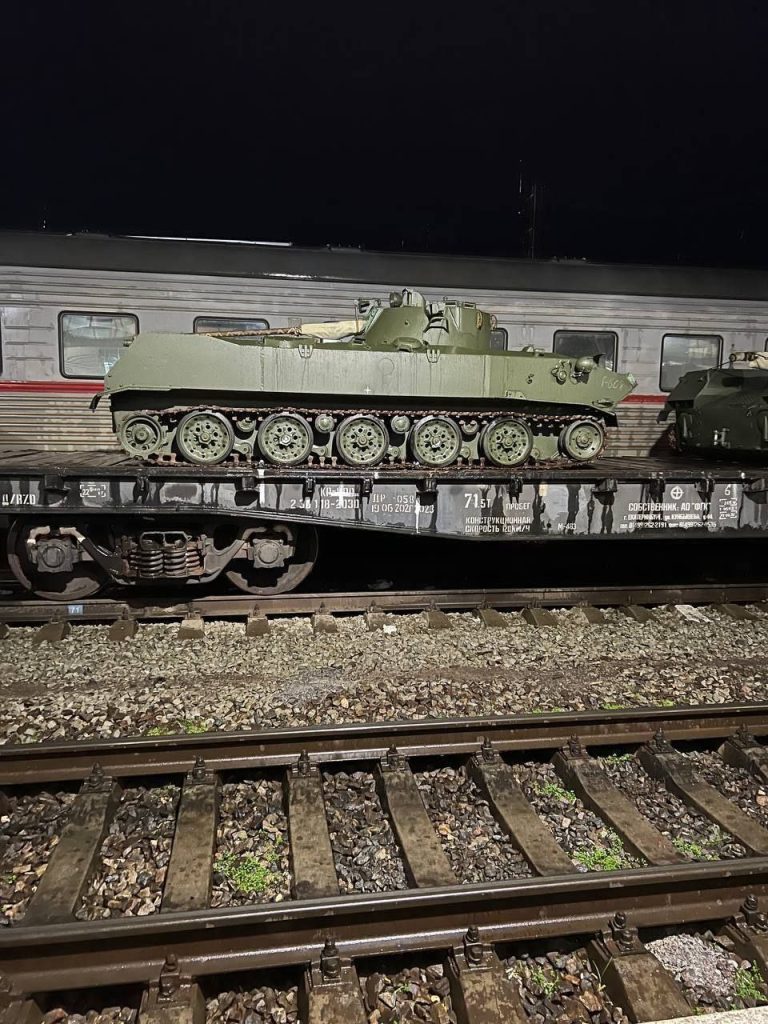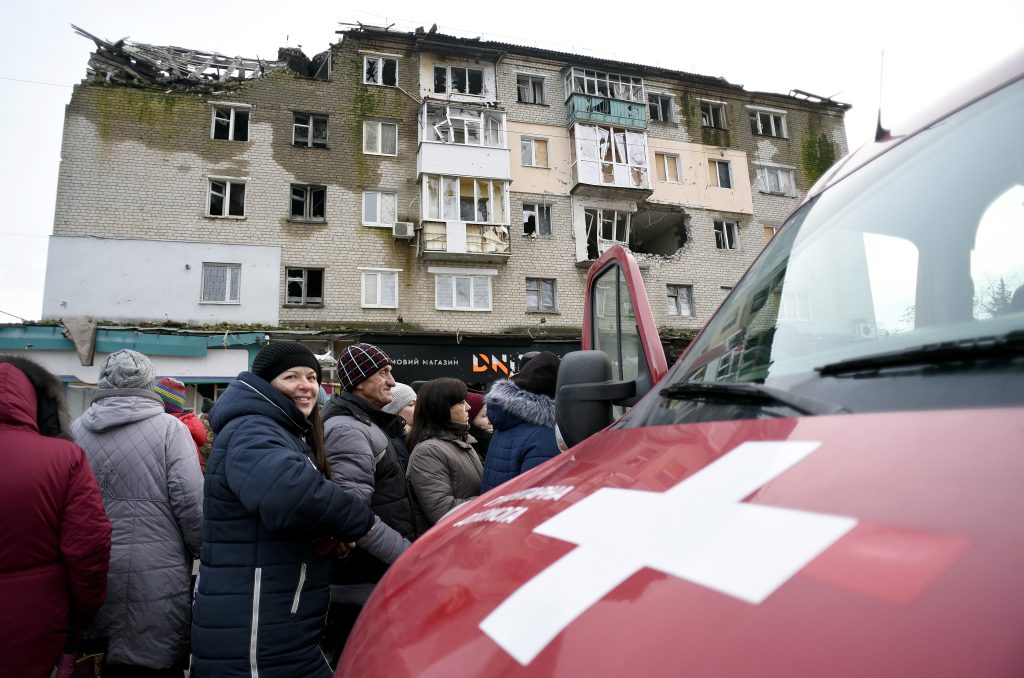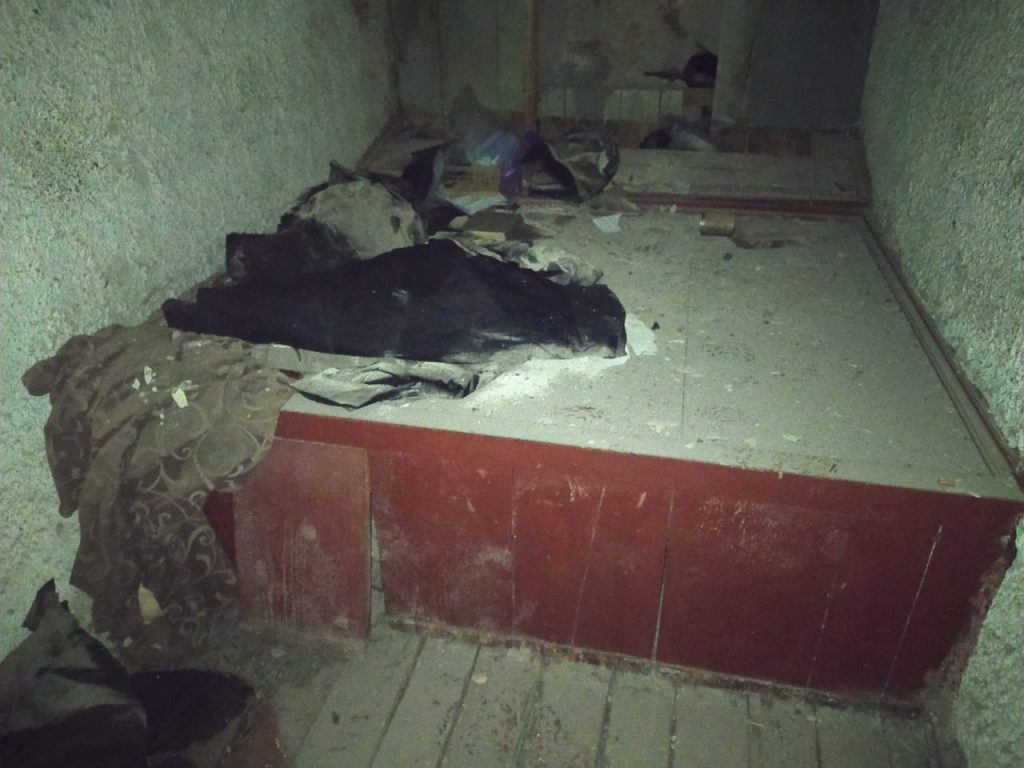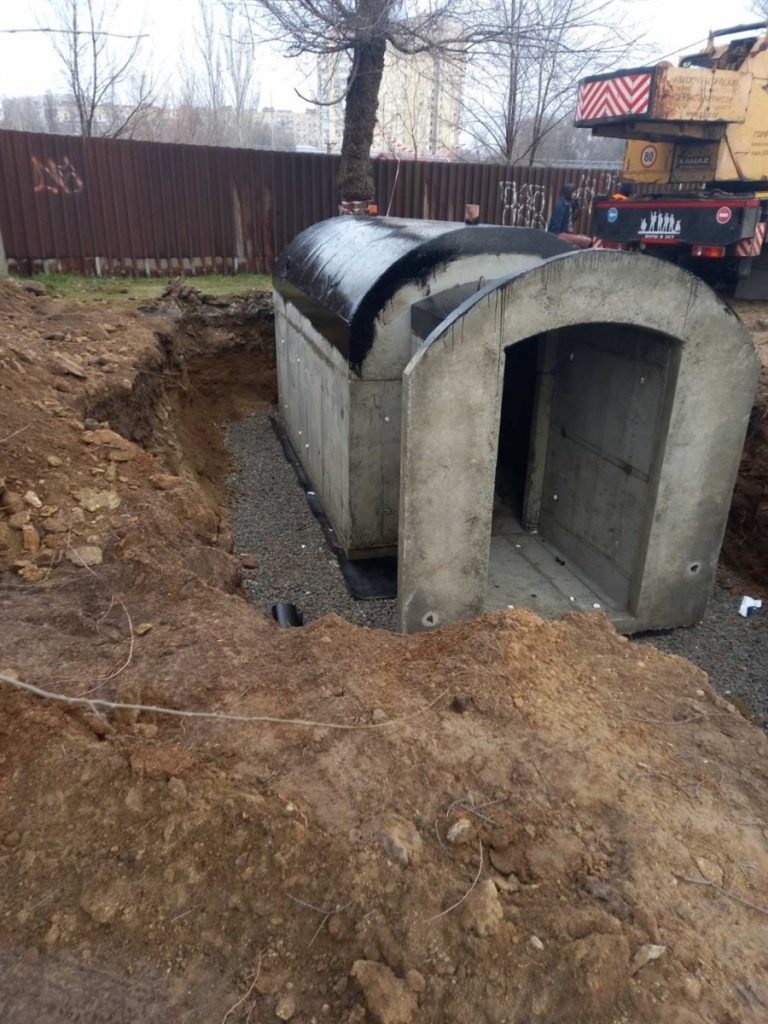The new year started with explosions in occupied Crimea and intensified attacks on Ukrainian positions, despite the so-called “Christmas ceasefire” proclaimed by Moscow.
During the week of January 2 – January 9, Russian soldiers carried out offensive operations on the Bakhmut, Soledar, Avdiivka, and Lyman fronts, and tried to improve their tactical position on the Kupiansk front, near Kharkiv.
Occupying forces banned the circulation of hryvnia, the Ukrainian currency, in Russian-held territories and raided stores to identify if it was still being used. They ordered retailers to mark price tags only in Russian rubles and, in some cases, threatened to seize goods if they found payments with hryvnia.
The Russian army continues the illegal conscription of Ukrainian citizens in occupied territories. Universities in Crimea have been ordered to expel students of conscript age with poor academic records so they can be mobilized, while in Horlivka, Donetsk Oblast, Russia stepped up patrols as it seeks to draft 2,000 people from the city to fight.
The port in Mariupol is being turned into a military base, and the Russians plan to use it for the delivery of military equipment by sea in the spring. About 50,000 Russian civilians may also travel to the occupied city in January, tasked with demolishing and clearing it to a "zero" state.
Russian forces continued to take Ukrainian children from occupied territories to Russia, this time for “celebrations,” but in reality as a propaganda tactic to persuade them life is better there. They took 414 children from occupied Horlivka to Rostov Oblast as part of the program.
Crimea
Residents in different parts of the occupied peninsula, particularly Simferopol and Sevastopol, reported a series of explosions at the start of the new year. The occupation authorities claimed Russian air defenses shot down two Ukrainian drones over the sea on January 2. On the morning of January 4, local residents heard a number of explosions in Sevastopol, near the Belbek military airfield. The occupation authorities again reported two drones were shot down. The same explanation was given for an explosion in Dzhankoi (north of the peninsula) and published on a pro-Russian Telegram channel on January 3.
The Russian army continues to move new military units to the north of Crimea. Andrii Cherniak, from the Main Intelligence Directorate of the Ministry of Defense of Ukraine, said Russian forces are still building defensive lines both in the north of the peninsula and in the occupied section of Kherson Oblast.
Residents of Dzhankoi, a city in the north of the peninsula, reported an influx of military equipment on January 6, including 30 amphibious assault vehicles.


Notices giving advice on "How to behave under fire" have again been posted on doors in Kerch, near the bridge to Russia in the east of the peninsula, Crimean Wind reported.
At the same time, there is no information in residential areas about the location of bomb shelters or what they should look like.

Russian forces continue the illegal mobilization of men on the occupied peninsula to replenish their losses in the war. Military officials are identifying residents who have not yet fought and preparing to call them up, the General Staff of the Armed Forces of Ukraine reported. The occupying authorities in Crimea have also ordered universities to expel students of conscription age who fail classes, instead of allowing them to retake exams or resubmit assignments, the National Resistance Center said. Students enrolled in universities cannot be mobilized, so excluding those with poor academic records will increase the number of young people the Russians can enlist to fight.
Meanwhile, the number of graves where servicemen are buried has been growing in the peninsula.
“As of January 2, 2023, at least 243 soldiers of the Russian army have been buried in occupied Crimea. 143 of them were probably citizens of Ukraine. The number of burials may be higher,” the Office of the Representative of the President of Ukraine in Crimea said in a post on Facebook.
Obituaries and military memorial plaques are increasingly appearing on the peninsula, providing clear evidence that soldiers from Crimea are fighting for Russia and dying in Ukraine, according to Radio Free Europe’s Krym Realii website.
On January 5, Telegram channels reported a shortage of gas at filling stations in Simferopol, Sevastopol, and Saky. Some blamed it on the weather, but Denys Chystikov, deputy permanent representative of the president of Ukraine in Crimea, told the FREEDOM TV channel that attacks by Ukrainian forces had pushed up prices for fuel, medicines, and food on the peninsula.
“Offensive efforts by the armed forces are approaching the ‘land corridor,’ which is already in the line of fire,” Chystikov said. “Civilian carriers who used to deliver fuel and food through the land corridor are abandoning the route.”
Donetsk Oblast
Russian forces intensified their shelling of Ukrainian positions after precision strikes on Russian manpower and equipment in Makiivka on New Year’s Eve. Druzhkivka was hit multiple times on January 2, and the ice rink, which had been operating as a humanitarian warehouse, was destroyed.
The situation in the Soledar-Bakhmut-Maiorsk area remains the most complicated. Due to constant attacks and shelling by Russian troops, Bakhmut has been more than 60% destroyed, Pavlo Kyrylenko, head of the Donetsk Oblast Military Administration, told Rada Channel.
Other frontline cities in Donetsk Oblast, such as Kramatorsk and Kurakhove, have been under attack. The Russian army shelled Kurakhove, damaging residential buildings and a medical facility with more than 20 patients and hospital workers inside.

The Russian occupiers continue to demolish whole blocks of Mariupol. “Livoberezhnyi and Cheremushky districts are simply erased from the city map. The historical center is also being destroyed,” the Mariupol City Council wrote on Telegram. The City Council published a photograph of a building with a hand-painted sign above its door saying, “Residents are against demolition of this house.”
About 50,000 Russian civilians may travel to Russian-occupied Mariupol in January to help the occupying authorities demolish the city and clear it to a “zero” state, Petro Andriushchenko, advisor to the legitimate mayor of Mariupol, reported on Telegram.
The port in Mariupol is being turned into a military base, and the Russians plan to start the delivery of military equipment by sea in the spring. “In late December, all residents of Mariupol were fired from the port (except for individual experts/collaborators), and workers were brought in from Moscow,” according to Petro Andriushchenko, adviser to the legitimate mayor of Mariupol. “Work has begun on dividing piers into conventionally civilian and conventionally military ones.”
The forcible integration of occupied territories into the Russian Federation continues. In Horlivka, the turnaround time for issuing Russian passports has been shortened from 30 to 10 days.
The occupiers plan to mobilize 2,000 people from Horlivka for the war against Ukraine. The National Resistance Center reported that “for this, the number of patrols has already been increased in the city.” Restrictions preventing the drafting of civil servants are also being removed in preparation for the new wave of mobilization.
Russian authorities continue taking Ukrainian children on trips to Moscow, Rostov and other large cities in an attempt to show them the advantages of life in the Russian Federation. “The occupiers took 414 children from temporarily occupied Horlivka to the Rostov region for ‘celebrations’,” according to the National Resistance Center. “At these events, children are exposed to propaganda, and the main goal is a "game of contrast", where children are shown a "happy and carefree" life in the Russian Federation in contrast to the war in Ukraine. Thus imprinting in the children's memory the superiority of the Russian Federation over their Motherland.”
Meanwhile, in the liberated part of Donetsk Oblast, the Ukrainian authorities are repairing infrastructure. In Lyman and Sviatohirsk, which were liberated from the Russian army in September and October, mobile phone networks have been restored. ATMs and shops, as well as banks, are being opened gradually. Electricity is being restored in some settlements.
Kharkiv Oblast
Despite the shelling of Kharkiv and other settlements of Kharkiv Oblast, the trials of people suspected of collaborating with Russian forces are still being held.
In one case, a woman accused of directing Russian fire on Kharkiv was returned to custody, and her detention was extended until February 19 without bail. Security forces detained the woman, who denies the charges, in April 2022, and she was sent to a pre-trial detention center while the case was investigated.
The Security Service of Ukraine says the woman handed over coordinates and helped Russian forces to adjust their fire on education, medical and commercial facilities, as well as residential areas in the center of the city. As a result of the rocket fire, many people were killed and injured, they say.
Two public workers who voluntarily acted as director and deputy in the city of Izium, before its liberation from Russian occupation in September, had the case against them transferred to court.
“During the investigation, new details were established - they were the ones who set up the Russian checkpoints in the city of Izium, destroyed Ukrainian symbols in the city, and conducted pro-Russian agitation,” Serhii Bolvinov, head of the Investigative Department of the National Police in Kharkiv Oblast, wrote on Facebook. They are also accused of theft and corruption, he said.

Law enforcement organizations continue to recover the bodies of those who died during the fighting and occupation. The body of a 6-year-old boy, who was killed in shelling on March 22, was exhumed from the cemetery in Izium on January 5 for forensic examination as part of a war-crimes investigation.
Kharkiv authorities continue restoring buildings that were destroyed by Russian rockets. In one block, in the Novobavarskyi district on the outskirts of the city, walls and heating were restored, and windows replaced, fixing damage caused by an attack on March 1. People are also being supported with cash from the city authorities and the Red Cross to repair their own apartments.
Kherson Oblast
The Russian army continues to attack Kherson and Kherson Oblast, firing on different settlements 70-80 times every day.
All islands in the Kherson Oblast section of the Dnipro River, including Velykyi [Great] Potomkin island, are in the so-called gray area, which is not clearly controlled by Ukrainian soldiers or the Russian occupiers. Yevhen Yerin, head of the joint press center for Ukraine’s defense forces on the Tavriia front, said control over the islands will only be possible after gaining full control over the east bank of the river.
The General Staff of the Armed Forces of Ukraine confirmed that on January 5, they struck a deployment center for Russian forces in the village of Havrylivka Druha, 29 km (18m) northwest of Armiansk on the border of occupied Crimea. Up to a hundred wounded invaders were taken to hospitals, and at least 20 officers are believed to have died, the statement said.
Russian forces continue to commit illegal actions against local residents in the Kherson region. “The occupiers collect information about people engaged in business activities and seize their vehicles and goods,” the General Staff of the Armed Forces wrote on January 2.
Russian soldiers in Nyzhni Sirohozy, 80km west of Melitopol, are also throwing people out of their homes at gunpoint and moving in, according to a police report posted on Facebook.
Following the announcement by the occupation authorities that they would stop the circulation of the Ukrainian hryvnia, in the village of Kakhovka, Russian soldiers conducted raids on retail outlets and threatened to seize not only cash but also goods if Ukrainian money was found, the General Staff of the Armed Forces of Ukraine reported.
Another torture chamber was discovered in Kherson as work continued to investigate abuses during the occupation. According to the National Police in Kherson Oblast, “the aggressors kept retired law enforcement officers, patriots, and ordinary Kherson citizens who refused to cooperate with the enemy in inhumane conditions. During the inspection, the officers discovered and seized objects and other evidence indicating that the occupiers tortured Kherson residents.”
A warehouse of looted Ukrainian symbols collected by the Russian military was discovered in one of the liberated settlements of Kherson region. “The occupiers deliberately collected Ukrainian symbols to send home as trophies from the so-called ‘special military operation,” the joint Press Center of the Tavriia Defense Forces reported on Facebook.




Luhansk Oblast
The Kreminna-Svatove highway is under the “fire control” of Ukrainian artillery, and as a result, the logistics of the Russian invaders have become more complicated, Serhii Haidai, head of the Luhansk Oblast Military Administration, said on January 3. While Ukraine’s Defense Forces are not physically on the road yet, Russian supply trucks are having to take time-consuming detours to avoid being attacked, Haidai said.
Resistance units continue working in the occupied settlements of Luhansk Oblast to help the Armed Forces of Ukraine. On the evening of January 6, partisans destroyed a railway track, near the occupied town of Schastia, used by the Russians to transport military equipment, troops, and ammunition.
Occupation forces blocked entry and exit from the village of Polovynkyne, 90km north of Luhansk, after they suspected residents of passing information to the Ukrainian army. Thirty local people were seized and taken to Luhansk because of the “collective responsibility” of the village, the National Resistance Center said. “At the same time, the Russian forces are trapped in their illusions and do not understand that almost every resident can report their position, because they are occupiers, not ‘liberators,’” the center said.
Despite the banning of the Ukrainian currency, “markets and small shops continue to accept hryvnias, particularly on bank cards,” according to the Luhansk Oblast Military Administration. “It did not disappear in exchange offices either, although it is at a correspondingly low exchange rate.”
Mykolaiv Oblast
The Kinburn Spit, a peninsula jutting into the Dnipro River’s access to the Black Sea, is the last part of Mykolaiv Oblast still under the control of Russian troops.
“They continue shelling the opposite bank and Ochakiv area, in particular, keeping control over the international transport routes in the Dnipro–Buh estuary, which makes it impossible to connect the Mykolaiv area to the grain agreement,” said Natalia Humeniuk, spokeswoman for the Pivden (South) Operational Command. “This is one of the enemy’s methods of economic terror.”
As of January 5, there were at least 12 potentially dangerous zones in Mykolaiv Oblast where mines have either been found or are likely to have been laid by Russian troops. According to the website of Ukraine’s Mine Countermeasures Service, the most dangerous places are located in the area around Snihurivka, which was liberated from the occupiers in November.
In the liberated village of Chervona Dolyna, in the Snihurivka hromada (municipality), police specialists also found a high-explosive aerial bomb containing approximately 250kg (550 pounds) of TNT. Serhii Shaikhet, head of the regional police, published a picture of the bomb on his Telegram channel.
The Security Service of Ukraine uncovered a torture chamber set up by the Russians in a private house in the liberated village of Oleksandrivka. Russian military personnel forcibly detained, interrogated, and tortured local residents who refused to cooperate with the occupation, the service said.
A 72-year-old man will go on trial in Mykolaiv for collaboration with the invaders. Mykolaiv regional prosecutor’s office said the man gave Russian forces information about the location of Ukrainian military personnel and infrastructure. In August and September, he is accused of handing over information about the results of artillery shelling on Mykolaiv, including detailed photos of the impact of attacks on its bridge, shipyard, and higher education institutions.
Zaporizhzhia Oblast
Russian forces continue to suffer losses on the Zaporizhzhia front. The General Staff of the Armed Forces of Ukraine confirmed that on January 2 in the areas of Tokmak, Melitopol, Berdiansk, Polohy, and Vasylivka, two ammunition depots and as many as 10 units of military equipment of various types were destroyed, two deployment centers damaged, and up to 260 Russian servicemen killed and wounded.
A large number of settlements in Zaporizhzhia Oblast remain under attack by the Russian army.
“The long-suffering cities of Orikhiv and Stepnohirsk are again under heavy artillery fire from the enemy,” Oleksandr Starukh, head of the Zaporizhzhia Oblast Military Administration, wrote alongside images of the destruction on Telegram. “Buildings are being burnt and collapsed. Our cultural heritage is being destroyed.”
The Russians are limiting the freedom of movement in occupied territory. According to Ivan Fedorov, the mayor of Melitopol, in some villages near Tokmak, "curfew days" have been imposed, and residents were forced to stay inside until January 8. In Tokmak itself, such restrictions were applied from the evening of January 6.
Curbs on movement also meant the Russians only allowed one person to go to Ukrainian-controlled territory along the “corridor of life” evacuation route in two weeks.
The head of an educational institution was allowed to make the journey. “They brought him and dropped him off in Vasylivka, and he walked 15 kilometers to Kamianske on foot,” said Oleksandr Starukh, head of the Zaporizhzhia Oblast Military Administration. “He is the only person who was able to leave the occupied territories in the last two weeks. For all others, the path is closed. They set restrictions until January 15. At the moment, there are no signs that the corridor will be opened and that people will be able to leave.”
The Russians also continue to put psychological and physical pressure on the civilian population of the occupied territories.
They stopped the broadcast of all Ukrainian TV channels in Melitopol and the village of Pryazovske, in Zaporizhzhia Oblast, where only Russian television is now available, the General Staff of the Armed Forces of Ukraine reported.
Russian occupiers in the town of Enerhodar forced about 3,000 employees of the Zaporizhzhia Nuclear Power Plant to obtain Russian passports. The Ukrainian hryvnia was also taken out of circulation by threatening entrepreneurs with fines and confiscation of property.
In an exclusive interview with CEPA in December, Melitopol Mayor Ivan Fedorov said the Russian occupiers’ decision to withdraw the Ukrainian hryvnia will make the population even poorer. According to his information, 80% of all residents in the city are unemployed, and between 5,000 and 7,000 retirees can’t get their pensions as they receive them in cash from Ukrainian post offices, which don’t operate there.
Russian medics are also reported to be fleeing Melitopol to escape the Ukrainian counter-offensive. Fedorov said it had now been almost a month since the occupiers started bringing wounded and sick soldiers to the city, and there is less and less space for civilians in the hospital. The extremely high number of wounded Russian soldiers, for whom there are neither enough medical staff nor hospital beds, and the behavior of occupiers admitted to hospital in a state of alcoholic or drug-induced intoxication, is adding to the problem, Fedorov said.


The Security Service of Ukraine identified three occupiers it suspects of torturing civilians in Zaporizhzhia Oblast. Two of them were from the Makhachkala detachment of special purpose militia (better known as OMON) of the Rosguard in the Republic of Dagestan. The men are accused of abducting people and torturing them to discover the whereabouts of Ukrainian patriots in the area.
In Zaporizhzhia, five modular shelters have been installed in recreation areas to protect people using the facilities from missile attacks. The shelters, which have been placed in parks and on city beaches, each provide protection for up to 15 people, Zaporizhzhia city council said.





